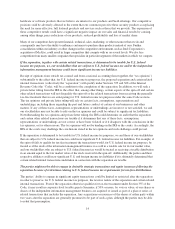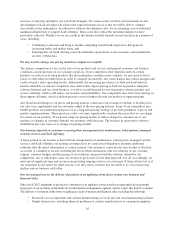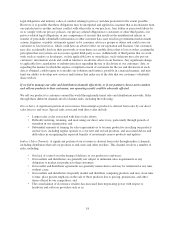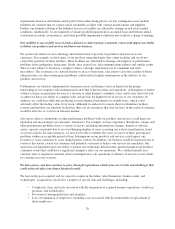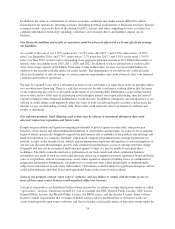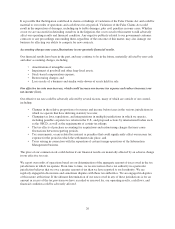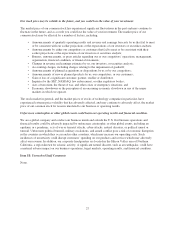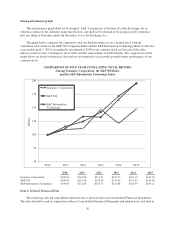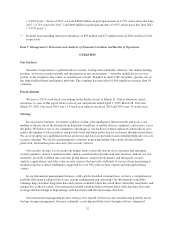Symantec 2015 Annual Report Download - page 101
Download and view the complete annual report
Please find page 101 of the 2015 Symantec annual report below. You can navigate through the pages in the report by either clicking on the pages listed below, or by using the keyword search tool below to find specific information within the annual report.result in reduced sales of our products. Any legal action to protect proprietary information that we may bring or
be engaged in with a strategic partner or vendor could adversely affect our ability to access software, operating
system, and hardware platforms of such partner or vendor, or cause such partner or vendor to choose not to offer
our products to their customers. In addition, any legal action to protect proprietary information that we may bring
or be engaged in, could be costly, may distract management from day-to-day operations, and may lead to
additional claims against us, which could adversely affect our operating results.
From time to time we are a party to lawsuits and investigations, which typically require significant
management time and attention and result in significant legal expenses, and which could, if not determined
favorably, negatively impact our business, financial condition, results of operations, and cash flows.
We have been named as a party to lawsuits, including patent litigation, class actions and governmental claims,
and we may be named in additional litigation. The expense of defending such litigation may be costly and divert
management’s attention from the day-to-day operations of our business, which could adversely affect our
business, results of operations, and cash flows. In addition, an unfavorable outcome in such litigation could result
in significant fines, settlements, monetary damages or injunctive relief that could negatively impact our ability to
conduct our business, results of operations, and cash flows.
Third parties claiming that we infringe their proprietary rights could cause us to incur significant legal
expenses and prevent us from selling our products.
From time to time, third parties may claim that we have infringed their intellectual property rights, including
claims regarding patents, copyrights, and trademarks. Because of constant technological change in the segments
in which we compete, the extensive patent coverage of existing technologies, and the rapid rate of issuance of
new patents, it is possible that the number of these claims may grow. In addition, former employers of our
former, current, or future employees may assert claims that such employees have improperly disclosed to us the
confidential or proprietary information of these former employers. Any such claim, with or without merit, could
result in costly litigation and distract management from day-to-day operations. If we are not successful in
defending such claims, we could be required to stop selling, delay shipments of, or redesign our products, pay
monetary amounts as damages, enter into royalty or licensing arrangements, or satisfy indemnification
obligations that we have with some of our customers. We cannot assure you that any royalty or licensing
arrangements that we may seek in such circumstances will be available to us on commercially reasonable terms
or at all. We have made and expect to continue making significant expenditures to investigate, defend and settle
claims related to the use of technology and intellectual property rights as part of our strategy to manage this risk.
In addition, we license and use software from third parties in our business. These third party software licenses
may not continue to be available to us on acceptable terms or at all, and may expose us to additional liability.
This liability, or our inability to use any of this third party software, could result in shipment delays or other
disruptions in our business that could materially and adversely affect our operating results.
Adverse global economic events may harm our business, operating results and financial condition.
Adverse macroeconomic conditions could negatively affect our business, operating results or financial condition
under a number of different scenarios. During challenging economic times and periods of high unemployment,
current or potential customers may delay or forgo decisions to license new products or additional instances of
existing products, upgrade their existing hardware or operating environments (which upgrades are often a
catalyst for new purchases of our software), or purchase services. Customers may also have difficulties in
obtaining the requisite third-party financing to complete the purchase of our products and services. An adverse
macroeconomic environment could also subject us to increased credit risk should customers be unable to pay us,
or delay paying us, for previously purchased products and services. Accordingly, reserves for doubtful accounts
and write-offs of accounts receivable may increase. In addition, weakness in the market for end users of our
products could harm the cash flow of our distributors and resellers who could then delay paying their obligations
to us or experience other financial difficulties. This would further increase our credit risk exposure and,
potentially, cause delays in our recognition of revenue on sales to these customers.
23



